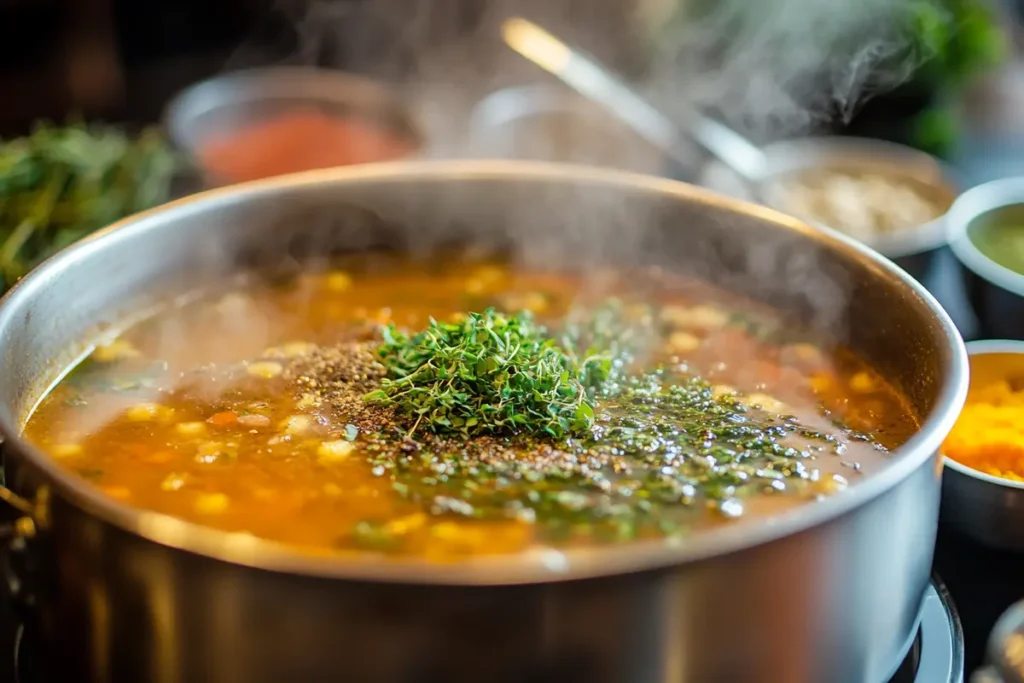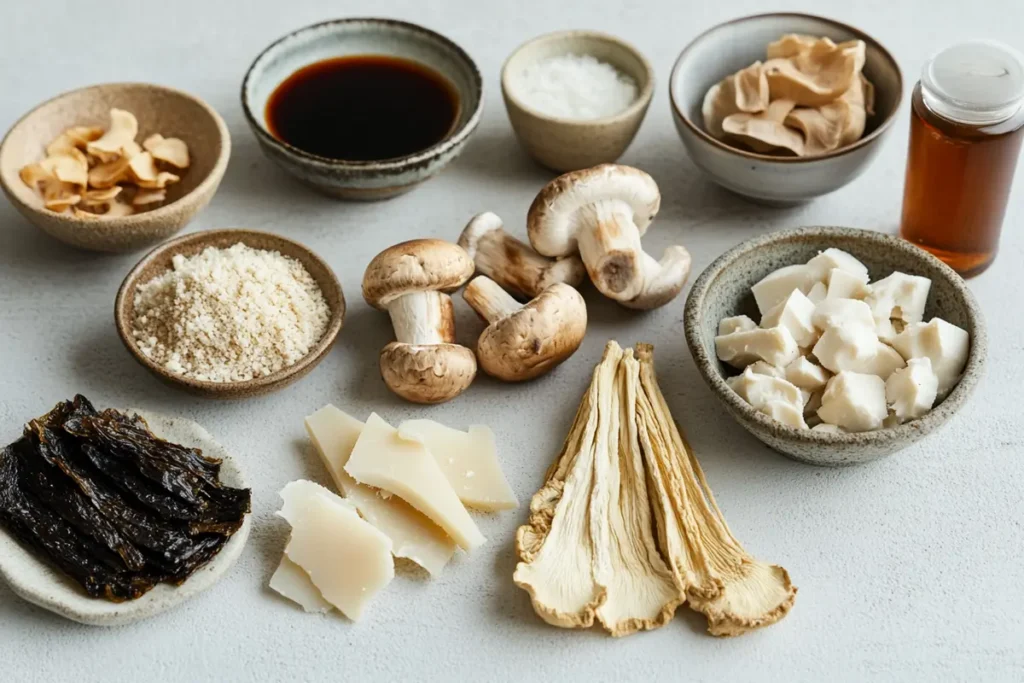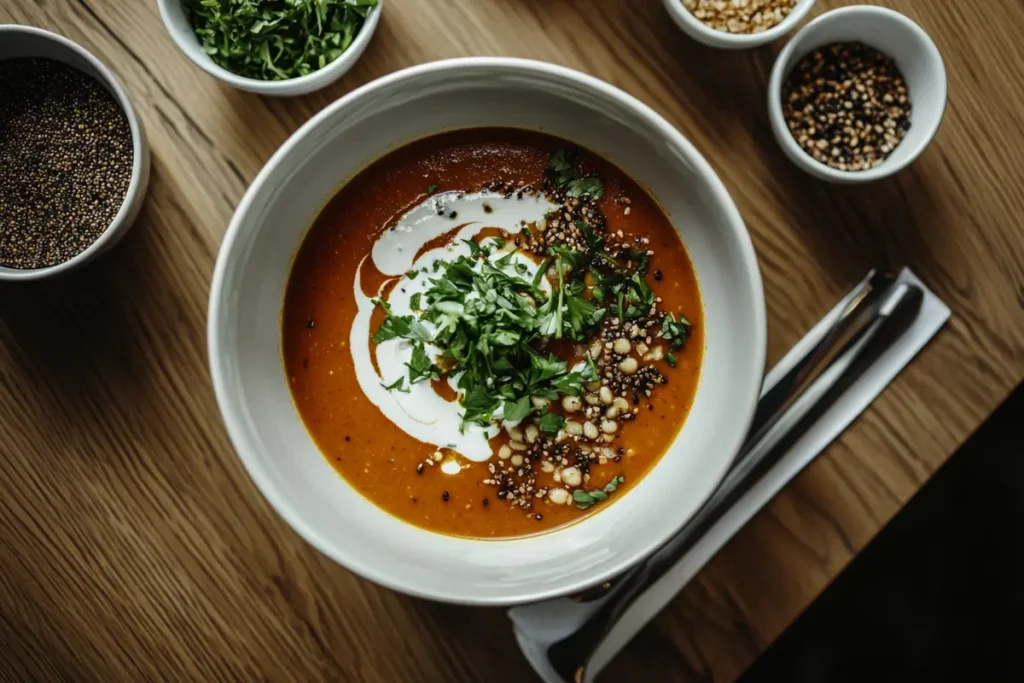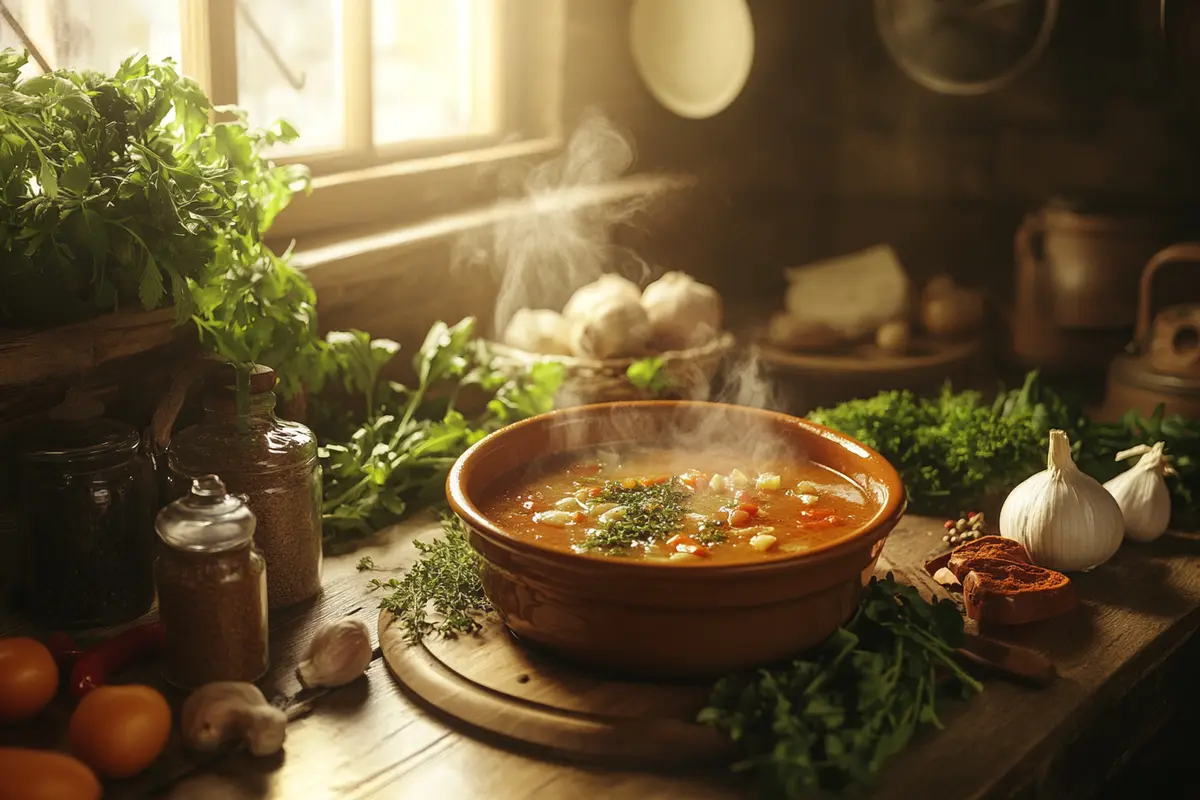What is the secret ingredient in soup? Many home cooks and seasoned chefs seek that elusive element. They want something that transforms a simple broth into a comforting bowl of warmth. However, discovering this secret goes beyond any single spice or herb. Instead, it involves understanding flavor balance, quality ingredients, and patience. Therefore, exploring this topic helps you create soups that captivate your palate and impress your friends.
Understanding Flavor Balance and Dept
Crafting a great soup often depends on achieving depth. Therefore, think about how flavors interact. A blend of savory, sweet, sour, salty, and even bitter notes can create complexity. When one dimension stands out too strongly, the soup loses harmony. For example, too much salt overwhelms delicate flavors. Too little seasoning leaves the broth flat and dull. However, achieving balance means adjusting each element until it feels just right.
In addition, consider the role of umami. Umami provides that savory depth that makes broths and stocks satisfying. Ingredients like mushrooms, tomatoes, or dried seaweed often boost umami. Adding a small amount of miso or fish sauce can also increase umami richness. Therefore, the “secret” behind a full-bodied soup might lie in these subtle umami enhancers. They work quietly, making the final dish taste richer and more complete.
Freshness also contributes to flavor depth. Using fresh vegetables, herbs, and spices can elevate a soup’s aroma and taste. Choose ripe tomatoes, crisp celery, and fragrant thyme. For instance, adding a handful of fresh parsley at the end brightens the entire bowl. Each choice builds layers that culminate in a complex, nuanced flavor profile.
Embracing Slow Cooking and Patience
Often, What is the secret ingredient in soup? is not about a single item but rather the process. Slow cooking allows flavors to merge and evolve. Therefore, give your soup time to simmer gently. Fast boiling can make flavors harsh and disjointed. A slow, steady simmer encourages ingredients to release their essence and harmonize.
In addition, patience helps you adjust seasoning gradually. Taste your soup as it cooks and tweak the balance as needed. Adding salt or acid incrementally prevents overshooting the ideal flavor. Also, consider resting your soup off the heat for a short period. Letting it sit allows flavors to settle. Sometimes, soup tastes even better the next day because the flavors have had time to mingle.
Remember, cooking soup is an art that rewards patience. The heat extracts complex notes from bones, vegetables, and herbs. The longer and gentler the process, the richer the result. That gentle simmer might be the hidden secret that brings everything together. By controlling heat and time, you set the stage for a fulfilling bowl that comforts and delights.
Balancing Acidity and Sweetness
Flavor balance often hinges on acidity and sweetness. Therefore, adding a splash of vinegar or a squeeze of lemon can brighten your soup. Acidity counters richness and heavy flavors. It also helps highlight subtle nuances that might otherwise remain muted. Conversely, a small pinch of sugar can round out bitterness or overly acidic notes.
In addition, understand that these adjustments should be subtle. Add a little vinegar, then taste. If your soup feels flat, consider a few drops of apple cider vinegar or a dash of sherry vinegar. On the other hand, if you find the soup too tangy, balance it with a pinch of sugar. This interplay ensures that no single flavor dominates. Instead, each element supports the whole.
Using Herbs and Spices Wisely
Herbs and spices can feel like secret weapons. Therefore, choose them thoughtfully. Common herbs like thyme, rosemary, and bay leaves offer depth. Delicate herbs like chives or dill add freshness. Spices, such as cinnamon, nutmeg, or star anise, can introduce intriguing warmth. The challenge lies in knowing when and how much to use.
In addition, remember that dried and fresh herbs behave differently. Dried herbs intensify as they simmer. Fresh herbs, added at the end, preserve delicate aromas. Therefore, a layered approach works best. Add dried thyme early, then finish with a handful of fresh parsley at the end. This strategy ensures complexity without losing bright flavors.

Understanding Cultural Influences on Soup Flavo
Different cuisines approach soup in distinct ways. Therefore, exploring global traditions can provide insight. For example, Japanese miso soup relies on umami-rich fermented soybean paste. Vietnamese pho features aromatic spices like star anise and cinnamon. French onion soup highlights caramelized onions and hearty beef broth.
In addition, analyzing these traditions can reveal common patterns. Many cuisines rely on a balanced broth, fresh aromatics, and careful seasoning. Some add fermented elements, while others focus on slow-simmered bones or seafood. By studying these global approaches, you gain a deeper understanding of soup-making principles. Therefore, borrowing techniques from other cultures can elevate your own creations.
The Power of Umami-Boosting Ingredients
Umami stands as the fifth basic taste, often described as savory depth. Therefore, adding umami-rich ingredients can transform a simple soup into something extraordinary. Mushrooms, soy sauce, miso paste, fish sauce, Parmesan rind, and dried shiitake are examples. Even a spoonful of tomato paste can intensify umami.
In addition, umami supports other flavors, making them taste rounder and more complete. Consider adding a strip of dried kelp (kombu) to your broth. This Japanese ingredient infuses the stock with a subtle yet profound savoriness. Similarly, adding a Parmesan rind to a minestrone soup imparts creamy, nutty undertones without overwhelming other flavors.

Texture and Mouthfeel: The Unsung Factors
Flavor matters, but texture also affects the soup’s overall impression. Therefore, consider mouthfeel. Creamy soups benefit from blending, while brothy soups rely on the clarity of their liquid. Adding lentils or beans can increase body and thickness. A velouté or bisque achieves its smoothness by pureeing the base and sometimes adding cream or butter.
In addition, consider garnishes that add texture. Crispy croutons, toasted nuts, or a drizzle of oil offer contrast. Fresh herbs or thinly sliced radishes can provide crunch and brightness. Texture variation keeps each spoonful interesting. It also reminds us that the secret ingredient might not be a flavor, but rather a textural element that enhances the eating experience.
Balancing Health, Nutrition, and Flavor
Soup can be both nourishing and delicious. Therefore, consider nutrition when selecting ingredients. Adding plenty of vegetables provides fiber and vitamins. Lean proteins like chicken or legumes offer body and sustenance. Whole grains, such as barley or farro, make the soup more filling without compromising flavor.
In addition, controlling the amount of fat and salt helps maintain healthful balance. You can use a small amount of healthy fats from olive oil instead of relying solely on butter or cream. Herbs and spices can replace excessive salt. This approach ensures that your soup tastes amazing and supports well-being.
Responding to Dietary Preferences and Restrictions
Modern kitchens must accommodate various dietary choices. Therefore, consider how to adapt your soup. If someone avoids dairy, use coconut milk for creaminess. For vegetarians, rely on vegetable broth and umami-rich mushrooms. If gluten is an issue, skip wheat-based thickeners and opt for cornstarch or pureed beans.
In addition, these adaptations often lead to exciting flavor combinations. A vegan soup might rely on miso or nutritional yeast for depth. A gluten-free chowder might use pureed potatoes for thickness. By working with dietary restrictions creatively, you discover new textures and flavors that expand your soup-making repertoire.
Using Leftovers and Transforming Ingredients
Soup excels at transforming leftovers into something delicious. Therefore, think of soup as a canvas for odds and ends. Wilted greens, roasted vegetables, or small pieces of cooked meat can find new life in a simmering broth. With creativity, these leftovers become part of a flavorful, satisfying meal.
In addition, using leftovers reduces waste. That aligns with sustainable cooking practices. Turning leftover roast chicken into a hearty broth is both economical and flavorful. Adding last night’s roasted carrots or grilled zucchini introduces complexity. Your soup evolves from random scraps into a cohesive dish.
Presentation and Serving Suggestions
A beautiful presentation enhances the soup experience. Therefore, garnish with care. Fresh herbs add color and fragrance. A swirl of cream or a drizzle of oil creates visual appeal. Toasted nuts or seeds add crunch and contrast. Presenting your soup attractively makes it even more inviting.
In addition, serve soup with complementary sides. A slice of crusty bread or a simple green salad can complete the meal. Pairing flavors and textures outside the bowl adds another dimension to the dining experience. This thoughtful touch conveys care and attention to detail.
Overcoming Common Soup Challenges
Sometimes, soup-making poses challenges. Perhaps your broth tastes thin or your vegetables seem bland. Therefore, learn from these difficulties. If the soup lacks depth, add umami boosters like a Parmesan rind or dried mushrooms. If it tastes too salty, dilute with unsalted broth or add a starchy ingredient to absorb some salt.
In addition, correct texture issues by blending part of the soup or adding thickening agents. If the soup seems too fatty, skim excess fat or use leaner proteins next time. Over time, you become agile at troubleshooting. This skill ensures that no matter the issue, you can steer your soup toward success.
Experimenting with Global Flavor Profiles
As mentioned earlier, cultural inspiration can spark new ideas. Therefore, try making a Mexican-inspired tortilla soup with chili peppers and lime. Experiment with a Thai coconut soup featuring lemongrass, ginger, and fish sauce. These global flavors teach you new ways to season and garnish.
In addition, blending these ideas with your own style leads to signature soups. Perhaps you combine the creaminess of a French bisque with the heat of a Thai tom yum. The result: a unique fusion that impresses your guests. This willingness to try something new answers What is the secret ingredient in soup? by showing that curiosity matters.
Keeping Track of Your Success
Documenting your soup-making journey helps you learn and improve. Therefore, write down recipes, note ingredient proportions, and record adjustments you make. Include what worked, what didn’t, and how each batch tasted the next day. Over time, these records guide you toward consistent excellence.
In addition, comparing past notes helps you discover patterns. Perhaps you find that adding a teaspoon of vinegar at the end always brightens your soups. Or you learn that a pinch of sugar tames bitter greens. Recognizing these patterns transforms guesswork into reliable techniques.
Embracing Simplicit
Sometimes, the simplest soups taste the best. Therefore, resist the urge to overcomplicate. A clean chicken broth with a few vegetables can soothe and satisfy. A humble lentil soup seasoned with basic aromatics can feel comforting and nourishing.
In addition, simplicity allows each ingredient to shine. Complex soups have their place, but simple ones highlight the purity of flavor. The secret ingredient might be the confidence to do less, trusting your ingredients and technique to deliver a memorable meal.
Personalizing Your Soup Signature
After absorbing all these ideas, you might wonder which approach to embrace. Therefore, consider your own palate and preferences. Maybe you adore spicy flavors and incorporate chili flakes. Perhaps you love earthy mushrooms and focus on umami. The secret ingredient might vary from one cook to another.
In addition, your personal signature might involve a specific garnish or finishing touch. Maybe you always sprinkle toasted pumpkin seeds on top. Or perhaps you finish with a drizzle of quality olive oil. These personal touches define your style and make your soups unique.

Final Thoughts: The Ever-Evolving Secret
So, What is the secret ingredient in soup? Ultimately, no single item or technique holds the key. Instead, the secret lies in understanding flavor balance, choosing quality ingredients, embracing patience, and fine-tuning every step. This process evolves with practice, experimentation, and curiosity.
In addition, each cook’s secret may differ. For some, it might be a dash of vinegar. For others, a spoonful of miso or a handful of fresh herbs. Over time, as you gain experience, you realize that the secret ingredient is never static. It adapts to your tastes, moods, and memories.
Frequently Asked Questions
What is the most important ingredient in soup?
The most important ingredient often varies, but quality broth usually ranks first. A rich, homemade broth sets a solid foundation. It enhances every other flavor. Without a good base, no amount of seasoning can achieve true depth.
Why do chefs put vinegar in soup?
Chefs add vinegar to brighten flavors and add subtle acidity. This acidity cuts through richness and helps highlight delicate ingredients. A few drops can transform a dull soup into a lively, balanced dish.
What is the secret to a good soup?
The secret involves balancing flavors, using fresh ingredients, and adjusting seasoning. Patience also matters. Slowly simmering and tasting as you go allows you to achieve the right harmony. Layering umami, adding fresh herbs at the end, and fine-tuning acidity are all key steps.

